Village Hall
202 South Main Street
Horseheads, NY 14845
Phone: 607-739-5691
Our Village
Welcome to the historic Village of Horseheads, gateway to the Finger Lakes and Upstate New York. Our Village offers a variety of shops, restaurants, and recreational activities for residents and visitors. Experience soaring in a glider, a glass of wine at one our unique Finger Lakes Wineries, visit one our many museums that span art, history, famous people, and aviation, and other recreational activities. We encourage you to visit and welcome you all to be a part of our Village while you are here.
History of Horseheads

How did Horseheads get it's name?
Horseheads is the first and only town and village in the United States dedicated to the service of the American Military Horse. A twenty-eight square mile memorial, unparalleled in American Military History, is the proud distinction that enshrines the town and Village of Horseheads, New York.
September 24, 1779 - this date hallmarks the time and hallowed ground where lie the true relics and sun-bleached skulls of the American Military Pack horses of the armies of Major-General John Sullivan. These peaceful servants of General Sullivan and his officers, with about 5000 “ragged rebels” (as expressed by King George III) brought forth a gallantry in the American Revolutionary War’s western campaign against the Six Nations of Native Americans (Iroquois).
Burdened down with heavy military equipment in their 450-mile journey through a wooden wilderness from Easton, PA over to Wyoming, and on up the Susquehanna River Trail to Elmira, NY, they continued north through Horseheads to the Finger Lakes Region and west to Geneseo. Returning the same route to Horseheads, these military pack horses had reached the end of their endurance. Here, General Sullivan, through humanitarian reasons was compelled to dispose of these partners in the cause of American freedom.
A few years later, the skulls of the horses were arrayed along the trail in defiant fashion by a few returning Native Americans, as a gesture that the same fate would be met by any settler, should he attempt to homestead on this location. The first settlers, reading these Native American signs, promptly built their homes on the spot. The Town and Village of Horseheads rose in tribute to glorify the event. This location, first known as “The Valley of Horses Heads” was later changed to Horseheads, New York.
Our Village was incorporated on May 15, 1837 as “Fairport”, not Horseheads originally, because of its location on the Chemung Canal which had then been in operation nearly four years. The sixteen-mile feeder canal coming down the valley from Corning joined the Chemung Canal just a short distance northeast of Hanover Square. The important office of the Toll Collector was located here, and all boats and barges were required to stop, have their cargoes weighed and pay tolls on same. There was a lock on West Franklin St. where old and young gathered to watch the boats “locked through”.
There were many people who loved the old revolutionary-born name and urged its return. Due to their efforts, the name Horseheads was restored in 1845. Again in 1885 the name was changed to North Elmira. Just one year and much political fireworks later the old name was returned.
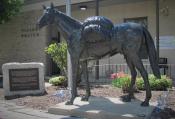
The Pack Horse Statue
General Sullivan mercifully put down his pack horses in this valley while returning from his campaign with the Iroquois Indians.
Leah Cramer (one of our esteemed Village Historians) introduced the idea of recognizing the military pack horse as part of our heritage and was the leading force in obtaining the statue to celebrate the 175th Anniversary of the Village of Horseheads.
The beautiful bronze statue can be found proudly standing in front of Village Hall at 202 South Main Street.
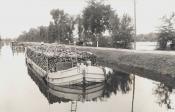
The Chemung Canal
The Chemung Canal began construction in 1830 and became full operational in 1833. Forty-nine wooden locks were needed to raise and lower barges and ships in the canal. The canal helped to transport coal, lumber and agricultural products from the Southern Tier and Pennsylvania northward.
The canal ended at Seneca Lake in Watkins Glen where the barges were towed the length of the lake from Watkins Glen to Geneva to connect with the Cayuga and Seneca canal system and later with the Erie Canal. Additionally, there was a feeder canal that had water from the Chemung River that connected Corning to the main canal located in Horseheads and allowed goods to be moved northward.
The Chemung Canal closed permanently in 1878 due to costly maintenance and repairs and because the railroad boom destroyed the canal's business.
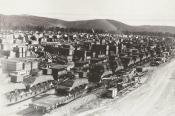
The Holding Point
During WWII the United States Army established the Holding and Reconsignment Point in Horseheads. The facility was built in 1942 when the federal government used eminent domain to have it constructed. This site was chosen because of the extensive railroad network in the area.
The Holding Point was staffed by thirty officers and men from the Army Transportation Corps as well as approximately 500 civilian men and women.
This location was one of only ten sites around the United States that served the army as a location to collect and store military supplies and equipment such as tanks as well as weapons that were then shipped overseas to aid in the war effort.
In 1944, approximately 200 German prisoners of war (POWs) went to work at the Holding Point. They were transported daily from a local camp in Van Etten, the former Civilian Conservation Corps camp. The German POWs were only at the Holding Point for two weeks before being transported to Sodus Point.
In August 1944, the 146th Italian Service Unit arrived at the Holding Point. The Italian Service Units were comprised of captured Italian soldiers that volunteered to serve with the United States Army.
After the war, the Holding Point was sold and it has become an important industrial site in the area.
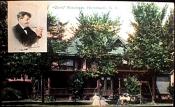
Eugene Zimmerman (1862 - 1935)
"Eugene Zimmerman was perhaps the most prominent cartoonist and caricaturist of his generation. His humorous work, often satiric and biting, was featured in the popular magazines Puck and later Judge, and was followed closely by an admiring public.
A native of Switzerland, Zim married Mabel Beard of Horseheads in 1886, and settled in the village to seek “a more gentle life.” He periodically commuted to New York City to fulfill his professional commitments. For his family, Zim built a gabled home in town, and financed and designed a community bandstand in Teal Park. The whimsically decorated structure is still used for weekly band concerts during the summer.
The Zimmerman’s only daughter, Laura, lived in the original Pine Street home until her death in 1980. Zim House was willed to the Horseheads Historical Society, which maintains it today. “The house appears much as it did when Zim was in residence,” says historian Leah Cramer. “Many of his 40,000 or so sketches, along with his correspondence, artifacts, desk and drawing board, remain in the home.”
The Queen Anne-style home with its fine carpentry, unique windows, balconies, and flowing rooms is on the National Register of Historic Places, and is open to the public." article written by James P. Hughes for www.lifeinthefingerlakes.com
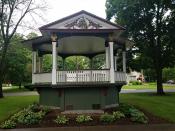
Teal Park Bandstand
The Teal Park Bandstand was designed and built by “Zim” and his father-in-law in 1910. The Bandstand was built in 1910 for the Z’s Band which was comprised of Mr. Zimmerman and a small group of his musician friends. Located on South Main St, it has weekly summer band concerts. It has been placed on the National Register of Historic Places.
Today, it is the home of the Teal Park Concert Series which begins on a Thursday in June and runs through August. Concerts are held each Thursday throughout the summer to the delight of hundreds of local music lovers. Local bands provide the entertainment and you might hear country-western, jazz, dixieland or barbershop harmony on any given night. Bring a lawn chair and enjoy the free entertainment with family and friends.
